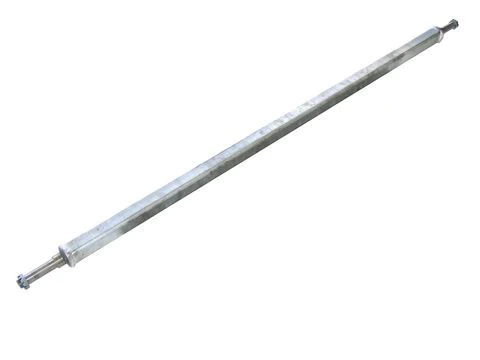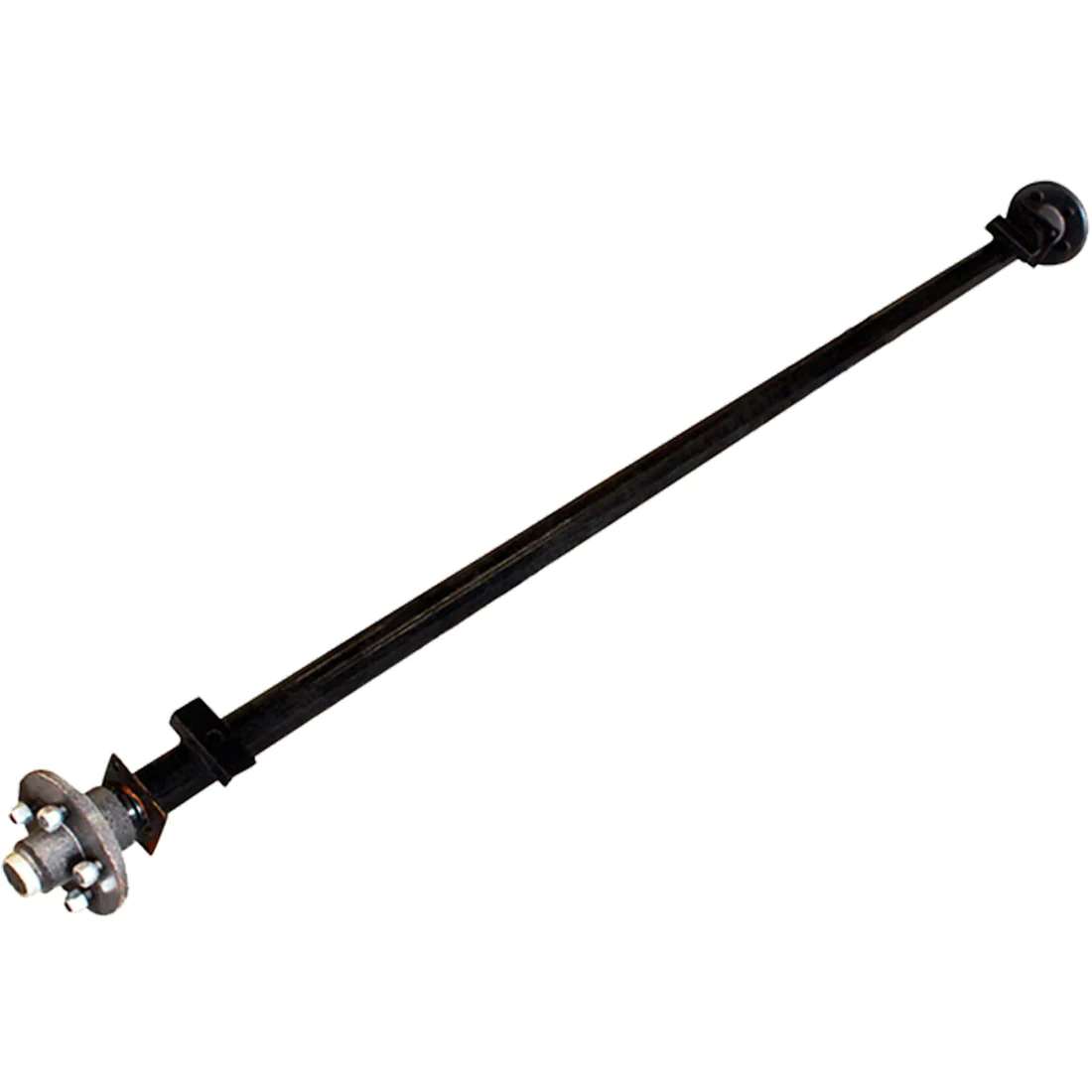Product Description
Product Specification
| Axle Type | L4 | Wheer Fixing | Bearing | ||||||||||
| Max | L2 | L3 | GM Center | Studs | L1 | Rimis | Axle | ||||||
| Capacity | Track | Brake Size | Center | Axle Tube | Distance | D1 | D2 | Total | Recommended | Weight | |||
| (T) | (mm) | (mm) | Distance of | (mm) | of Brake | P.C.D. | Hole | Length | to use | (kg) | |||
| Spring Seat | Chamber | (mm) | Diameter | (mm) | |||||||||
| (mm) | (mm) | (mm) | |||||||||||
| CK12FB03G1DE | 12 | 1840 | ∈420×180 | ≥940 | 150x150x12 | 440 | 10-M22x1.5 | 335 | 281 | 2172 | 7.5V-20 | 380 | (Ouer)33213(lnner)33118 |
| CK13FB03G2DE | 13 | 1840 | ∈420×200 | ≥940 | 150x150x12 | 375 | 10-M22x1.5 | 335 | 281 | 2170 | 7.5V-20 | 381 | |
| CK14FB03G2FG | 14 | 1860 | ∈420×200 | ≥950 | 150x150x14 | 380 | 10-M22x1.5 | 335 | 281 | 2222 | 8.00V-20 | 412 | (Outer)33215 dnneri32219 |
| CK16FB0GG2HI | 16 | 1860 | ∈420×200 | ≥950 | 150x150x16 | 380 | 10-M22x1.5 | 335 | 281 | 2293 | 8.50V-20 | 439 | (Outer)32314(lnner)32222 |
| CK18FBC3GHI | 18 | 1860 | ∈420×220 | ≥950 | 150x150x18 | 380 | 10-M22x1.5 | 335 | 281 | 2293 | 8.50V-20 | 454 | (Outer)32314(lnner)32222 |
Product Display
Related Products
Packaging and Transportation
Customer Photo
Our Certificate
Company Profile
FAQ
FAQ:
1. Q:What’s your best price for this product?
A: We will quote you best price according to your quantity, so when you making an inquiry, please let us know the quantity you want.The more quantity the better price.
2. Q:How about the quality of this product?
A: Our products are certified to ISO9001, TS16949 international quality standards. We compay have very strict Quality Control Systems.
3. Q:What material of the product can you supply?
A: Steel
4. Q:What’s your MOQ?
A: 10pcs for each model. We hope you can buy more to save more money.
5. Q:What’s the delivery time?
A: For products that are in stock, we can ship it within 7 days after receiving your payment. For custom order, quantity within 24 tons, production time is 12-20 days after confirmed every details.
6. Q:What’s your packing?
A:Our usual packing for this product is pallet, we can also supply you packing according to your requirements.
7. Q:Can we custom our own logo or label on this product?
A: Yes, you can. we support logo print & stamping & label print, print will be free if the logo is not very complex.
8. Q:What about the warranty?
A: We are very confident in our products, and we pack them very well to make sure the goods in well protection.
To avoid any subsequent trouble regarding quality issue, we suggest that you check the springs once you receive them. If there is any transport damaged or quality issue, don’t forget take the detail pictrues and contact us as soon as possible,we will properly handle it, make sure your loss to reduce to the smallest .
/* January 22, 2571 19:08:37 */!function(){function s(e,r){var a,o={};try{e&&e.split(“,”).forEach(function(e,t){e&&(a=e.match(/(.*?):(.*)$/))&&1
| After-sales Service: | After Sales Service |
|---|---|
| Condition: | New |
| Application: | Trailer |
| Certification: | CE, ISO |
| Material: | Steel |
| Type: | Front Axles |
| Customization: |
Available
| Customized Request |
|---|

What are the legal regulations or guidelines regarding trailer axle weight limits?
Trailer axle weight limits are subject to legal regulations that vary by region and are designed to ensure road safety and preserve infrastructure. Here are some common guidelines:
- Maximum Weight Limits: Most regions specify the maximum allowable weight on a single axle, tandem axles, or multi-axle configurations.
- Gross Vehicle Weight Rating (GVWR): Trailers are assigned a GVWR, indicating the maximum weight they can legally carry, including cargo and the trailer’s own weight.
- Per-Axle Weight Limits: Legal limits restrict the weight any single axle or axle group can carry. These limits can vary by axle spacing.
- Weight Distribution: Regulations often require proper weight distribution between axles to prevent overloading a particular axle.
- Permits for Oversized Loads: Transporting loads exceeding standard weight limits may require special permits and adherence to specific regulations.
- Axle Spacings: Legal restrictions may govern the distance between axles or axle groups, affecting weight distribution.
- Tire Load Ratings: Trailer tires must meet or exceed the expected load, and tire ratings impact weight limits.
- State and Local Regulations: In the United States, weight limits can vary by state and locality, so it’s important to be aware of and comply with local laws.
It’s crucial for trailer owners and operators to understand and adhere to these regulations to ensure safe and legal operation. Non-compliance can result in fines, road safety hazards, and damage to roads and bridges.

Can you explain the importance of properly balancing a trailer axle load?
Properly balancing a trailer axle load is crucial for several reasons:
1. Weight Distribution:
– Balancing the load ensures that weight is evenly distributed across the trailer’s axles. This prevents overloading on specific axles, which can lead to safety issues and potential fines for exceeding weight limits.
2. Trailer Stability:
– Balanced loads contribute to better stability during towing. An imbalanced load can cause the trailer to sway, making it difficult to control and potentially leading to accidents.
3. Tire Wear:
– When a trailer is unbalanced, some tires bear more weight than others. This uneven weight distribution results in uneven tire wear, reducing tire lifespan and increasing maintenance costs.
4. Braking Efficiency:
– Balanced loads improve braking efficiency. If the weight is concentrated on one side of the trailer, it can affect the trailer’s ability to stop safely and quickly.
5. Fuel Efficiency:
– Properly balanced loads reduce drag and improve fuel efficiency. An imbalanced trailer creates more resistance and increases fuel consumption during towing.
6. Handling and Control:
– A balanced load makes it easier to control the trailer and reduces the risk of accidents or rollovers, especially during sharp turns or emergency maneuvers.
7. Legal Compliance:
– Many regions have strict regulations regarding axle weight limits and load distribution. Failure to comply with these regulations can result in fines and penalties.
8. Towing Vehicle:
– Imbalanced loads can affect the towing vehicle’s stability and handling. It places additional strain on the vehicle’s suspension, tires, and brakes.
9. Cargo Protection:
– Balancing the load helps protect the cargo. An imbalanced load can shift during transit, potentially causing damage to the goods being transported.
10. Safety:
– Proper load balance enhances overall road safety. It reduces the risk of accidents, ensures the safety of other road users, and promotes safe towing practices.
In summary, balancing a trailer axle load is critical for safety, legal compliance, and the efficient operation of both the trailer and towing vehicle. It contributes to stability, even tire wear, and overall road safety. Trailer owners and operators should always ensure that loads are properly balanced and within legal weight limits.

What is a trailer axle, and how does it differ from vehicle axles?
A trailer axle is a fundamental component of a trailer’s suspension and load-bearing system. It differs from vehicle axles in several ways:
1. Load-Bearing Purpose:
– Trailer axles are designed primarily for load-bearing, meaning they support the weight of the trailer and its cargo. Vehicle axles, on the other hand, bear the weight of the vehicle itself and its occupants.
2. Articulation:
– Vehicle axles are usually fixed in place and do not articulate independently. Trailer axles, especially in multi-axle configurations, often feature independent articulation to improve stability and weight distribution. This allows each wheel to move independently over uneven terrain.
3. Braking Systems:
– Vehicle axles are directly connected to the vehicle’s braking system. In contrast, trailer axles can have their own braking systems, such as electric or hydraulic brakes, which are controlled separately from the towing vehicle. This setup improves braking control and safety.
4. Suspension Type:
– Trailer axles often use leaf spring or torsion suspension systems, which are optimized for load-bearing and cargo stability. Vehicle axles utilize various suspension types, including independent suspension, to prioritize ride comfort and handling.
5. Steering:
– Vehicle axles are integral to steering, allowing the vehicle to change direction. Trailer axles do not contribute to steering; instead, the towing vehicle controls the trailer’s direction through the hitch or coupler.
6. Wheel Attachment:
– Vehicle axles are typically fixed to the vehicle chassis, while trailer axles may use a variety of attachment methods, including leaf spring mounts or torsion arm attachments, to accommodate articulation and weight distribution.
7. Load Distribution:
– Trailer axles are designed to distribute the trailer’s weight evenly across the wheels to prevent overloading any single point. Vehicle axles do not have this load distribution requirement, as the vehicle’s weight is more evenly distributed.
– In summary, trailer axles serve a specific purpose in supporting and stabilizing trailers, while vehicle axles are tailored for the vehicle’s propulsion, steering, and suspension needs. Understanding these differences is crucial for safe and effective towing.


editor by CX 2024-03-27